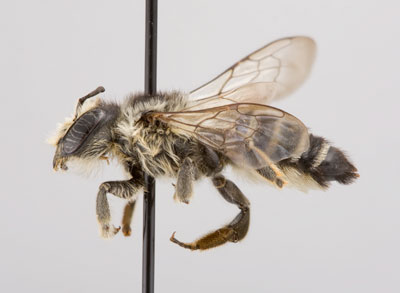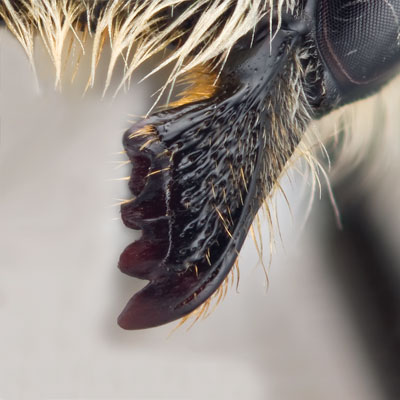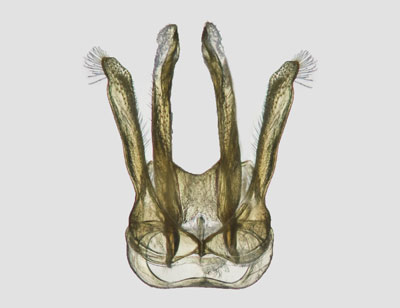
30. Megachile (Xanthosarus) addenda Say, 1837
Megachile addenda Female |
Megachile addenda Male |
Megachile addenda Cresson, 1878. Trans. Amer. Entomol. Soc. 7: 124 (♀, ♂).
Megachile manumuskin Viereck, 1902. Can. Entomol. 34: 328 (♀, ♂).
Diagnosis.The female of M. addenda can be recognized by the combination of 4-dentate mandibles with the emargination between inner (4th) and 3rd teeth distinctly oblique (i.e. greatest depth much closer to inner tooth than to 3rd tooth, T2‒T5 with carina of basal grooves strongly elevated and projected posteriorly, and T6 strongly concave in lateral view. They are most similar to M. manifesta and M. wheeleri, which have T2‒T4 with carina of basal grooves distinct, but weakly elevated and not projected posteriorly to from space beneath, T5 with carina scarcely or not perceptible, and T6 weakly concave to straight in lateral view. The male of M. addenda is recognized by the combination of 4-dentate mandibles, unmodified front legs, and has red bristles on the front coxa. They are most similar to M. parallela. The male of M. parallela has two pairs of prominent teeth on the apical margin of T6 (below the carina), and has no red bristles on the front coxa.
FEMALE: Length 11-14 mm.
Head:
Figure M30: Megachile addenda female mandible |
1) compound eyes subparallel to slightly convergent below; lateral ocelli slightly nearer eyes than to margin of vertex (5:6), 2) clypeal margin very slightly incurved and finely crenulate, 3) mandibles 4-dendate, with an incomplete cutting edge between 2nd and 3rd teeth, almost complete between 3rd and 4th teeth, 4th tooth narrowly rounded or subacute (Figure M30), 4) gena slightly broader than compound eye (7:6), 5) vertex shining, punctures fine, slightly separated across posterior margin, becoming more minute and separated lateral to ocelli, considerably closer and finer on gena; frons finely rugosopunctate, punctures somewhat separated on supraclypeal area medially and on mid-line of clypeus, becoming quite close and fine laterally, 6) pubescence white, rather dense and elongate around antennae and over lower half of face, on gena below, becoming sparse but still white on gena above, vertex with considerable rather short, erect, black pubescence, 7) F1 quadrate to just slightly longer than broad, subequal in length to pedicel and F2, remaining flagellomeres slightly longer than broad (2.3:2), apical flagellomere more elongate, almost twice as long as broad.
Mesosoma:
1) pubescence white, rather dense and elongate laterally and posteriorly, becoming sparse but still white on periphery of mesoscutum with considerable, rather short, erect black pubescence across disc, somewhat more elongate on scutellum, 2) mesoscutum shining, punctures fine, well separated in centre (≥1 pd) but close to almost crowded elsewhere, those on scutellum somewhat more sparse, very fine and close on axilla; pleura quite densely punctate beneath copious pubescence; propodeum smoother, somewhat shining, only vaguely and minutely punctate, triangle impunctate, smooth and shiny, 3) front and mid basitarsi quite broad, slightly narrower but very much shorter than their tibiae, hind basitarsus nearly equaling hind tibia in length and breadth, spurs yellowish-brown, 4) tegula shining, with scattered, very minute and slightly separated punctures, 5) wings subhyaline basally, becoming faintly infuscated apically, veins brownish-black.
Metasoma:
1) T2-T5 with transverse, very deep, complete grooves occupying nearly half of each disc, basal margin of grooves sharply and conspicuously carinate, apical margins of terga quite abruptly but narrowly depressed, occupied by dense, entire, white, apical fasciae; T1 with more erect, loose pubescence that is white laterally, more or less brown medially, discal pubescence of T2-T6 short but copious, entirely black; punctures on the more basal terga very fine and quite close, becoming slightly more distinct and separated but still close on the more apical terga; T6 distinctly concave in profile, with abundant, erect, blackish pubescence over most of disc, but the more apical hairs becoming densely appressed, 2) S6 with a somewhat bare, shining, median, apical area, with a short dense fringe of black hairs apically; S6 and apical edge of S5 with black scopal hairs, scopa otherwise yellowish-white; the sterna very closely and finely punctate on basal segments, becoming somewhat more coarse and sparse apically, apical margins of the sterna narrowly yellowish-hyaline.
MALE: Length 10-13 mm.
Head:
1) eyes subparallel; lateral ocelli slightly nearer eyes than margin of vertex (4:5), 2) clypeal margin straight, slightly crenulate, 3) mandible 4-dentate, 3rd tooth very low and inconspicuous, lower process narrow, elongate, and subacute, basal in position, 4) gena slightly broader than compound eye (6:5), 5) punctures of vertex fine but distinct, rather close medially, becoming more widely separated laterally (≤1 pd), very close and fine on gena, becoming crowded below; frons with densely crowded punctures, those on supraclypeal area and sides of face minute and densely crowded beneath dense pubescence, considerably coarser but close on clypeus dorsally, becoming minute and densely crowded apically, 6) pubescence quite copious and elongate, yellowish-white on face and clypeus, white and quite dense on gena, vertex with some erect, more or less brown pubescence intermixed with pale long hairs, 7) F1 about as long as broad, and subequal to pedicel, remaining flagellomeres longer than broad (3:2), apical flagellomere more elongate (5:2).
Mesosoma:
1) pubescence quite copious and elongate, yellowish-white laterally and posteriorly, mesoscutum with pale pubescence anteriorly, but with a patch of brownish hairs across posterior half, scutellum with a few brown hairs intermixed among the pale ones, 2) mesoscutum rather closely but distinctly punctate, punctures slightly separated medially, especially in anterior half, becoming close laterally and posteriorly, scutellum somewhat more finely but quite closely punctate, separated medially, punctures on axilla very fine and crowded; pleura dull, with densely crowded punctures beneath copious pubescence; propodeum smooth and somewhat shining, with only very minute, well spaced and obscure punctures, triangle dull and impunctate, slightly rugose basally, 3) front coxal spine well developed, rather short, quite slender, acute at tip, coxa with an obscure patch of short, decumbent, reddish-brown hairs at base of spine; middle spur short but well developed; all basitarsi short, simple and narrow, front and mid tarsi rather prominently white fringed posteriorly, spurs more brownish-black, 4) tegula shining, minutely and quite closely punctate, 5) wings subhyaline, veins brown.
Metasoma:
1) T2-T5 with complete, basal, transverse grooves, basal margin of each conspicuously carinate, apical margins of terga deeply depressed, conspicuously and densely white fasciate, pubescence of T1 and basal grooves of T2-T4 whitish, the more apical discal pubescence of T2-T5 erect and black; punctures of all terga minute, rather well separated but not sparse, becoming quite close toward depressed margins; T6 somewhat shining, largely bare, with only very fine, erect hairs, very finely and closely punctate, carina consisting of a pair of rounded, irregularly crenulate lobes delimiting a broad, rounded emargination, median teeth of apical margin hardly evident, lateral teeth small and acute but distinct; T7 acutely pointed medially, 2) S1-S4 exposed, surface shining, very minutely and rather closely punctate, apical margins narrowly yellowish-hyaline, S1-S3 rather densely fringed with long, white hairs, discs of sterna sparsely white pubescent.
Genitalia: Figure G30.
|
Figure G30: Megachile addenda genitalia |
Discussion:
Megachile addenda is a distinct member of subgenus Xanthosarus, prompting Mitchell to make it the monotypic member of the subgenus Addendella (Mitchell 1980). However, the characters used to key both sexes of Addendella by Mitchell (see Mitchell (1980), page 24) are in disagreement with published descriptions; females do have a distinct but incomplete cutting edge in the third interspace (see Mitchell (1962), Figure 43, page 133 and Figure M29 below), and males do have reddish-brown bristles at the base of each front coxal spine (see description in Mitchell (1962) and above). Although relatively uncommon in Canada, this species is considered an important and potentially manageable pollinator of cranberry in the United States (Cane et al. 1996). Megachile addenda is a ground nesting species (Table 1).
Distribution:
Primarily eastern, recorded from QC and ON (see Map 30).
|
Map 30: Canadian distribution of Megachile addenda |




